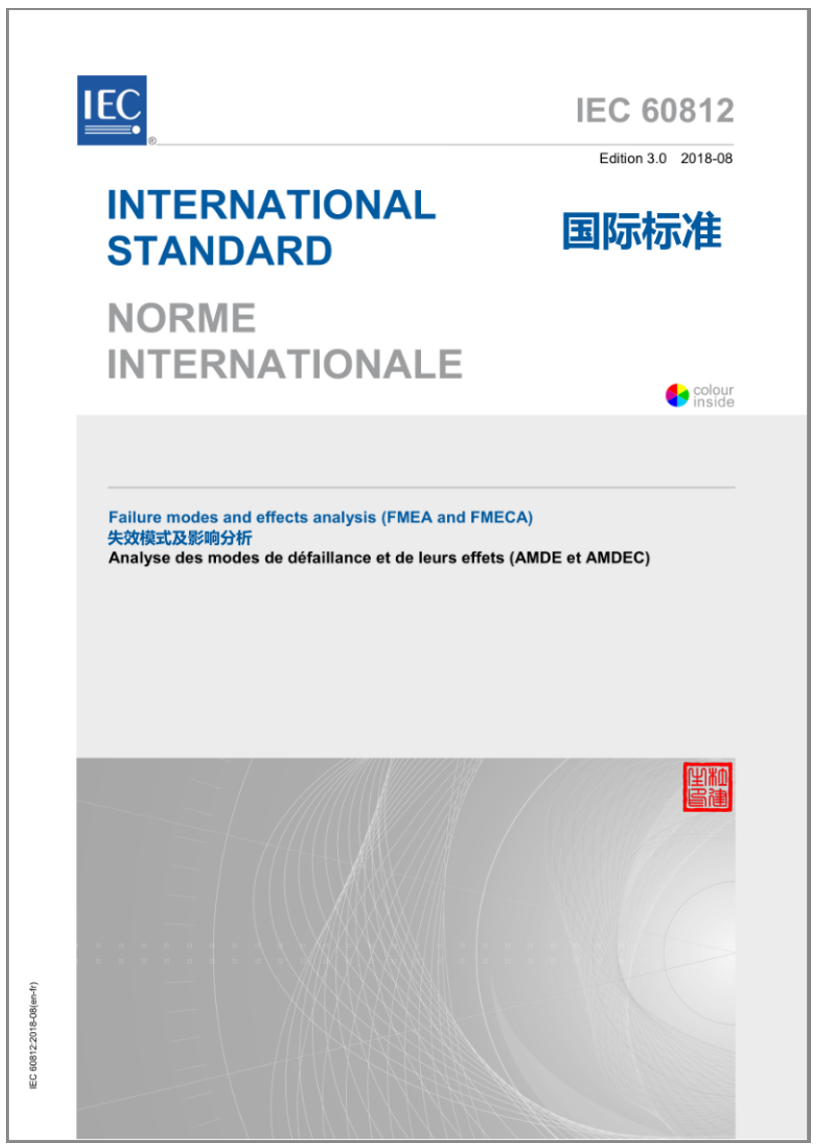作者:文思特咨询师杜建生
潜在失效模式及影响分析(FMEA)是一个可靠性工程/技术风险分析的重要工具。关于此项工具的应用方法及要求,可能大家都比较熟悉汽车行业发布的标准。而国际电工委员会(IEC)和其它一些行业的标准化组织给出的标准和指南大家就不是太熟悉。但这些标准和指南也非常有借鉴意义。为了使大家更好地学习和了解该工具的应用方法,也为了使汽车行业的朋友们更好地应用AIAG与VDA共同发布的FMEA手册工具,现将IEC 61082 《失效模式及影响分析(FMEA和FMECA)》附录A.1内容提供给大家供参考。这一资料采用中英文版本对照形式,如中文版本有不妥之处,则以英文版本为准。

Annex A (informative) General considerations for tailoring an FMEA
附录A(资料性附录)剪裁定制FMEA一般注意事项
A,1 General
A.1 总则
A.1.1 Overview
A.1.1 概览
Tailoring customizes an FMEA to provide a cost-effective way to achieve the FMEA objectives and involves making choices about:
剪裁定制FMEA,为实现FMEA的目标提供一种具有成本效益的方式,并涉及对以下方面的选择:
- the boundaries of the system, item or process to be analysed;
- 要分析的系统、事项或过程的边界;
- the start point in the hierarchy for the analysis;
- 进行分析的层次结构起始点;
- the level of detail of sub-division of the subject of the analysis into elements;
- 将分析主题细分为若干要素的详细程度;
- which analysis steps to consider;
- 要考虑哪些分析步骤;
- the level of detail within each analysis step;
- 每个分析步骤中的详细程度;
- whether failure modes will be prioritized based on their criticality and the assessment method to be used.
- 是否根据失效模式的危害性和采用的评估方法,来确定失效模式的优先级。
In general these choices will be informed by factors such as:
通常,这些选择会受到以下因素的影响:
- the purpose of analysis (e.g. to improve or modify an item or process, to produce a dependability case (IEC 62741), to demonstrate compliance, to plan maintenance or logistics support, safety);
- 分析的目的(如改进或修改事项或过程、制作一个可靠性案例(见IEC 62741)、证明符合性、计划维护或后勤支持、安全);
- the extent to which the process or item is new or innovative (e.g. technology);
- 过程或事项新建或创新(如技术)程度;
- the availability of relevant data (e.g. operational experience for similar items, test data);
- 相关数据的可用性(如相似事项的运行经验、检测数据);
- whether it is required to recommend treatments or whether this will be done by others outside the FMEA;
- 是否要求推荐处理方法,或者是否由FMEA之外其他人来完成;
- legal or contractual requirements;
- 法律或合同要求;
- for an item, the maturity of the design or project, and;
- 对于一个事项,设计或项目的成熟度,以及;
- the stage of the life cycle at which the FMEA is carried out.
- 执行FMEA的生命周期阶段。
In general, the possibility that some items or processes, or their elements, might not require an FMEA in any form should also be considered, particularly if there is no clearly identifiable benefit in performing the analysis or if other forms of dependability analysis are considered more useful. An FMEA gains its business value by, for example, influencing design, operations and providing information for the development of cost-effective preventive and corrective maintenance programmes. If the analysis results cannot influence these factors, then it might not be justified.
通常,还应当考虑到某些事项、过程或其组成部分可能不要求任何形式FMEA的可能性,特别是在完成的分析中没有识别FMEA的明确好处或认为其他形式可靠性分析更有用的情况下所产生的这种可能性。FMEA通过影响设计、运行和为制定具有成本效益的预防性和纠正性维护方案提供信息等方式,获得其业务价值。如果分析结果不能对这些因素产生影响,那么这一分析结果可能会是不合理的。
NOTE In many cases, commercial-off-the-shelf (COTS) items or elements from specialist suppliers can only be treated as 'black boxes' which can only be satisfactorily analysed for interfaces, such as inputs and outputs.
注:在某些情况下,来自专业供方的商用现货(COTS)事项或要素只能被视为“黑匣子”,而“黑匣子”只能对接口(如输入和输出)进行令人满意的分析。
Examples of tailoring choices in specific industry applications are given in Clause A.3. General application considerations for FMEA are given in Annex E.
A.3 条款中给出了特定行业应用中的剪裁定制选择示例。FMEA一般应用注意事项包含在附录E中。
A.1.2 Start point for FMEA in the hierarchy
A.1.2 层次结构中的FMEA起始点
The choice of start point for tailoring an FMEA depends upon the purpose and stage of the analysis and how best value is achieved (5.2.3.2).
剪裁定制FMEA的起始点选择,取决于分析的目的和阶段以及如何实现其最佳价值(5.2.3.2)。
Where the start point to the analysis is the top- or mid-levels in the hierarchy and the causes for the failure modes limited to the failure of the elements in the next lower level(s), this is referred to in this document as a top-down approach.
如果分析的起始点是层次结构中的顶层或中层,而失效模式的原因仅限于下一层要素的失效,那么这在本文件中称之为自上而下方法。
Where the start point to the analysis is for elements at the lowest level of the hierarchy relevant to the objectives, this is referred to in this document as a bottom-up approach.
如果分析的起始点是与目标相关的最低结构层次要素,那么这在本文件中称之为自下而上方法。
The top-down approach described is normally used in the early stages of design and hence may produce a result that is incomplete in depth and/or breadth as a result of deliberate limitation of scope or lack of available information. However, an early start to the analysis (using estimates where necessary) can have a positive impact on future item dependability and cost. If the project is continued to full scale development, the FMEA should be completed using the detailed ‘bottom-up’ approach so that it can fulfil its purposes.
上述自上而下方法通常在设计的早期阶段使用,因此可能产生一个在深度和/或广度上都不完整的结果,而这一结果是由于故意限制范围或缺乏可用信息所导致。然而,尽早开始分析(必要时使用概算方法),可以对未来事项的可靠性和成本产生积极的影响。如果项目继续全面发展,FMEA应该使用详细的“自下而上”方法来完成,这样做才能实现其目的。
NOTE 1 In this document, the term 'top-down' is used to describe the approach to developing the FMEA and it is not intended to be interpreted in the manner associated with fault tree analysis.
注1:在本文件中,术语“自上而下”用来描述开发FMEA的方法,这一术语不旨在以与故障树分析相关的方式来解释。
NOTE 2 If the analysis scope is more extensive than the inherent performance of the item (e.g. includes external events such as fire, flood or operator influence), or continued development is unlikely (e.g. a constrained feasibility study), then a fault tree analysis might be a more useful technique than FMEA.
注2:如果分析范围比事项的固有性能更广泛(如包括外部事件,如火灾、水灾或操作者的影响),或继续开发的可能性不大(如具有约束性的可行性研究),那么故障树分析可能是一种比FMEA更有用的技术。
Table A.1 summarizes the characteristics of top-down and bottom-up approaches. These characteristics allow the value for a given approach to be considered.
表A.1中总结了自上而下和自下而上方法的特点。这些特点使人们可以考虑以上特定方法的价值。
Table A.1 – Characteristics of top-down and bottom-up approaches to FMEA
表A.1 – FMEA自上而下和自下而上方法的特点
|
|
Characteristics/特点 |
|
Top-down 自上而下方法 |
Most often realized as a functional analysis that is intended to focus effort on the most important requirements or functions of the item or process. 最常实现的目的是进行功能分析,旨在是将努力集中在事项或过程的最重要要求或功能上。 In early stages of development where only the functional requirements on an upper level are known. 在开发早期阶段,只有上一层次的功能要求是已知的。 To help determine the structure of more detailed, later FMEAs (which may be then bottom-up), especially for complex systems. 帮助确定更详细和后续的FMEA结构(然后可能采用自下而上方法),特别是对于复杂的系统。 Can be applied where specific effects are of interest and only the failure modes require investigation. 可以应用于感兴趣的特定影响,并且只要求对失效模式进行调查。 Can be cost effective if analysis needs to place emphasis on specific elements or functions of interest. 如果分析需要将重点放在感兴趣的特定要素或功能上,则可能具有成本效益。 Allows assessment of the loss of function at item level, but limits the results to an assessment of how pre-defined failure events might occur, rather than attempting to identify all failures that could occur. 虽然允许对事项层次上的功能损失进行评估,但是要将结果限制在对预先定义可能发生失效事件的评估上,而不是试图识别所有可能发生的失效。 Requires judgement in assessing the point in the analysis where continuing to lower levels of the hierarchy would provide little or no useful information supporting the objectives of the analysis. 要求在评估分析要点时做出判断,而在这一要点上继续进行较低层次的分析,将会对支持分析目标很少或不能提供有用的信息。 Can support identification of requirements at lower levels. 可以支持对较低层次要求的识别。 |
|
Bottom-up 自下而上方法 |
Most often applied where the individual elements of an item or process are examined at the most detailed level relevant and the effects of their failure analysed at specified higher levels of the hierarchy. 最常用于在最详细的相关层次上,检查一个事项或过程的单个要素,并在规定的更高层次上分析其失效的影响。 Provides greater assurance that all potential failure modes have been considered as few assumptions are made regarding black box COTS or aggregated elements in complex throw-away modules. 提供了更大程度的保证,确保所有潜在的失效模式都已得到考虑,因为在复杂的一次性模块中,对黑匣子商用现货或聚合要素很少做出假设。 Well suited to identifying all possible effects when deploying an entirely new arrangement of components or existing items into a new environment or application. 非常适用于将一个全新组成安排或现有事项部署到一个新环境或应用时,识别所有可能的影响。 Often employed for new designs where the range of top-level or higher-level effects might not be known. 通常用于可能不知道顶层或更高层影响范围的新设计。 Requires no knowledge of the item top-level functional requirements since the loss of function at the item top-level is inferred by propagating the component failure effects up through the structure of the item hierarchy. 不要求知道事项顶层的功能要求,因为事项顶层功能损失是通过事项层次结构向上传递组成部分失效影响来进行推断的。 Can significantly increase the scale of the FMEA and hence the effort required for the analysis. 可以大大增加FMEA的规模,从而增加分析所要求付出的努力。 |
A.1.3 Degree of detail in analysis
A.1.3 分析的详细程度
FMEA can be developed to different degrees of detail to provide additional information, for example, to analyse potential treatment options or to assist related analyses in operating, maintenance or supporting a logistics programme. The depth and breadth of an FMEA will inevitably depend on the complexity of the system, item or process that is the subject of analysis.
FMEA编制可能产生不同的详细程度,以提供额外的信息,例如,分析潜在的处理选项,或协助操作、维护或支持后勤方案的相关分析。FMEA的深度和广度将不可避免地取决于作为分析主题的系统、事项或过程的复杂程度。
A.1.4 Prioritization of failure modes
A.1.4 失效模式优先级
Extending an FMEA to include a criticality analysis might be useful when a measure of the relative importance of a particular failure mode is required. Such information about relative importance can be used when planning priorities for treatment assessment and actions. If all failure modes are to be treated in some way (e.g. if required for regulatory compliance) then conducting a criticality analysis might not be useful.
当要求测量特定失效模式的相对重要性时,将FMEA扩展到包括危害性分析可能是有用的。这种关于相对重要性的信息,可以在策划处理评估和行动的优先级时使用。如果所有的失效模式都要以某种方式进行处理(例如,如果要求符合法律法规),那么进行危害性分析可能就没有用了。
Severity or criticality need not be the only consideration when deciding priorities for treatment. For example, the cost effectiveness of available treatments, the ease with which they can be implemented and the way in which they affect other parts of the system can also be considered.
在决定处理的优先级时,严重性或危害性不需要是唯一的考虑。例如,也可以考虑现有处理的成本效益、实施的难易程度以及影响系统其他部分的方式。
Assessment of parameters, such as severity and likelihood, might be based on quantitative, or qualitative measurement scales.
对参数的评估,如严重性和可能性,可能基于定量或定性的测量标准。
- Quantitative scales might be useful when relevant operating experience, test data or prediction is available enabling a failure rate or probability to be assigned to specific failure modes.
- 如果有相关的操作经验、检测数据或预测,可以将失效率或概率分配给特定的失效模式,定量标准可能是有用的。
- Qualitative scales might be useful when failures have to be prioritized, but detailed information is unavailable or the item is insufficiently defined to enable relevant quantitative data to be applied.
- 当不得不对失效进行优先排序,但却由于无法获得详细资料或事项确定不充分而无法应用相关定量数据时,定性标准可能是有用的。
Table A.2 summarizes the general application characteristics of qualitative and quantitative criticality assessments for top-down and bottom-up approaches to FMEA.
表A.2总结了在自上而下和自下而上的FMEA方法中,定性和定量危害性评估的一般应用特点。
Annex B provides detailed guidance on criticality analysis methods.
附录B提供了关于危害性分析方法的详细指南。
The guidance in Clause A.1 is general. More specific consideration might be required in given applications. For example, safety critical systems may require demonstrable evidence that they have either been designed or selected in a manner that transparently identifies, analyses, evaluates and treats the likelihood and severity of failure. The FMEA may be customized to show, for example, the traceability of mitigation or treatment together with evidence that the method used is appropriate to the application context. Further consideration of issues associated with common types of applications are discussed in Annex E.
A.1条款中指南是通用的。在特定的应用中可能要求更加具体的考虑。例如,安全关键系统可能要求可证实的证据,证明其设计或选择的方式能够透明地识别、分析、评估和处理失效的可能性和严重性。FMEA可以采用定制化,以展示诸如缓解或处理的可追溯性,以及展示所使用的方法适合于应用环境的证据。附录E讨论了与常见应用类型相关问题的进一步考虑。
Table A.2 – General application of common approaches to FMEA
表A.2 – FMEA常见方法的一般应用
|
|
Qualitative analysis/定性分析 |
Quantitative analysis/定量分析 |
|
Top-down 自上而下方法 |
Generally conducted in the early stage of an item design when the approach might be cost effective because it allows analysis to stop when reaching a level at which no further breakdown of the item design is possible or failure mode knowledge is unavailable for some other reason. 通常在事项设计的早期阶段使用,这时该方法可能具有成本效益,因为它允许在达到事项设计不可能进一步分解或由于其他原因而无法获得失效模式知识的水平时停止分析。 An example application is a low-cost confidence check that a defined OEM support regime for a mature item, which has some match to the expected failure modes in the design. This can be achieved by top-down analysis showing traceability between defined maintenance tasks and the failure modes mitigated or managed. 一个应用示例是对一个成熟事项的已确定OEM支持制度进行低成本的置信度检查,而OEM支持制度与设计中的预期失效模式有一定程度的匹配。这可以通过自上而下的分析来实现,从而展示已确定的维护任务与得到缓解或管理的失效模式之间的可追溯性。 A top-down approach in early design might not involve even a qualitative assessment if the purpose is to explore and understand failure modes and their effects only. 如果早期设计的目的只是探索和理解失效模式及其影响的话,那么早期设计中自上而下方法可能甚至不涉及定性评估。 |
Generally compatible with design of new items where the architecture is known and treatment is focused on identification of design improvement opportunities by prioritizing failure modes and their effects. 通常与新事项的设计相适应,在这种情况下,结构是已知的,而处理的重点是通过优先考虑失效模式及其影响来识别对于设计的改进机会。 Analyses of this form also provides an audit trail between the failure modes, their effects and the potential value of mitigating actions, but can be more difficult to do. 这种形式的分析,也提供了失效模式及其影响与缓解措施潜在价值之间的审核路径,但可能更难做到。 Generally justified where verifiable outcomes are necessary such as regulatory submissions or demonstration of a positive return on the invested effort is required. 通常在有必要产生可验证结果的情况下进行论证,例如要求提交监管文件,或证明投资努力得到了积极的回报。 |
|
Bottom-up 自下而上方法 |
Generally applied to existing, complex and often aging items where actual quantitative performance data might not be readily available. 一般适用于现有的、复杂的以及通常老化的事项,这些事项的实际定量绩效数据可能不容易获取到。 Might be used where significant modification of an item requires integration of new equipment during design and data is not available for a quantitative analysis. 在设计过程中对某一事项进行的重大修改要求整合新设备,而且没有用于定量分析的数据情况下,可使用这一方法。 Encourages analysis to start at a level of detail that satisfies the intent of the analysis (e.g. prevent application of FMEA to COTS items, where the effort will not assist understanding and there are few if any options to change the design). 鼓励分析从满足分析意图的详细程度开始(例如,防止对商用现货事项应用FMEA,因为这种努力无助于理解,而且几乎没有任何改变设计的选择)。 |
Generally useful at the completion of the item design to demonstrate compliance with design specification and provide detailed material for use by other analyses such as in safety or logistics support. 通常在事项设计完成后使用,从而证明对于设计规范的符合性,并为其它分析(如安全和后勤支持)提供详细的资料。 Analysis of this form might be lengthy, costly and generally justified only where large production volume or severe failure effects of a particular item mean that application of the FMEA process is likely to achieve a return on the invested effort. 这种形式的分析可能是冗长而昂贵的,通常只有在由于某一特定事项的生产量大或失效影响严重,因而只有应用FMEA过程才可能获得投资努力回报时使用才是合理的。 |
在线课程



